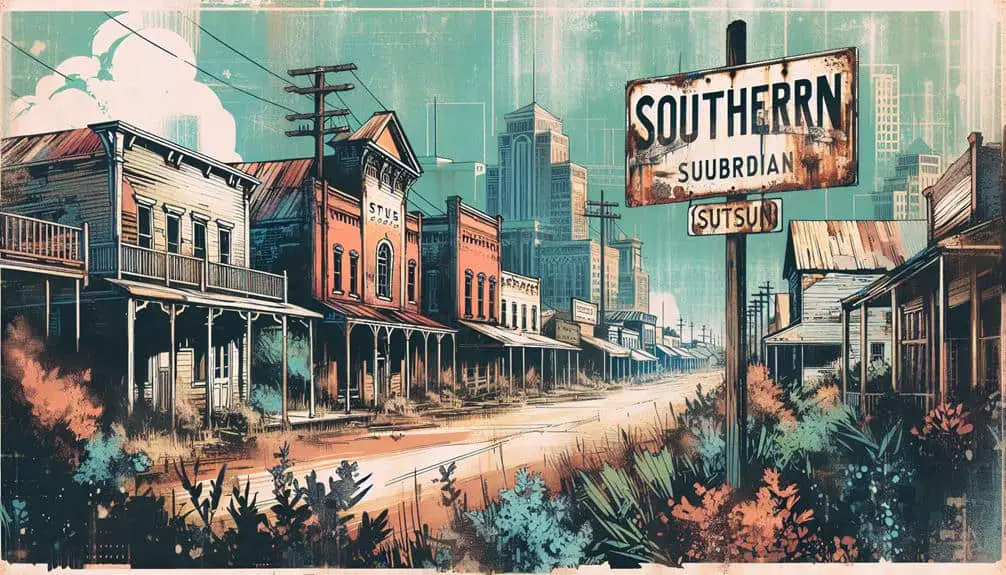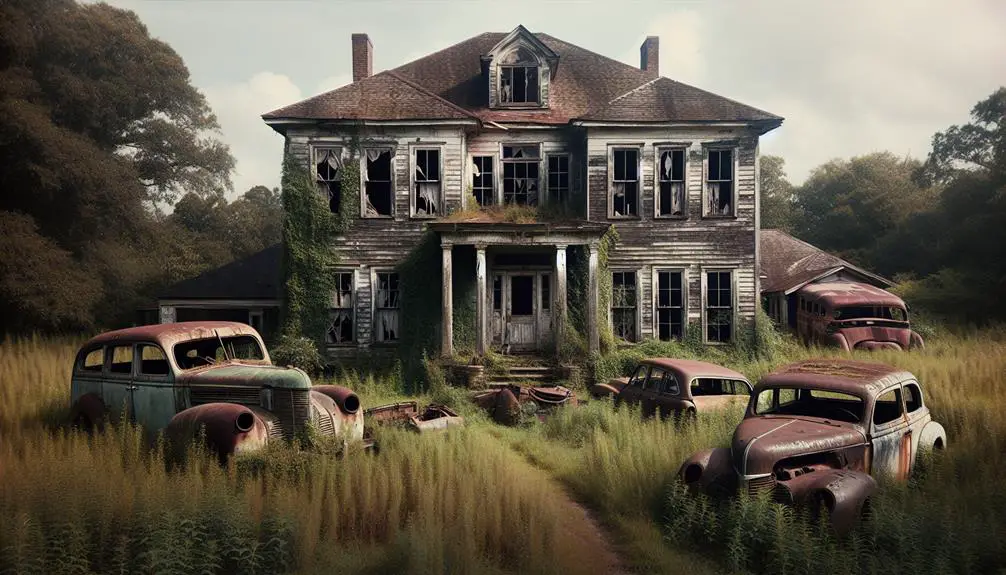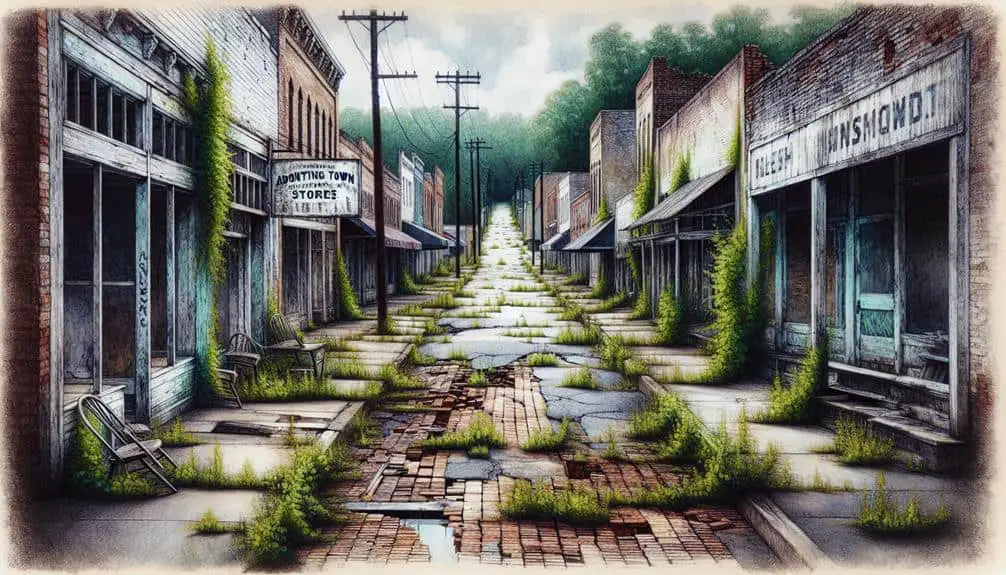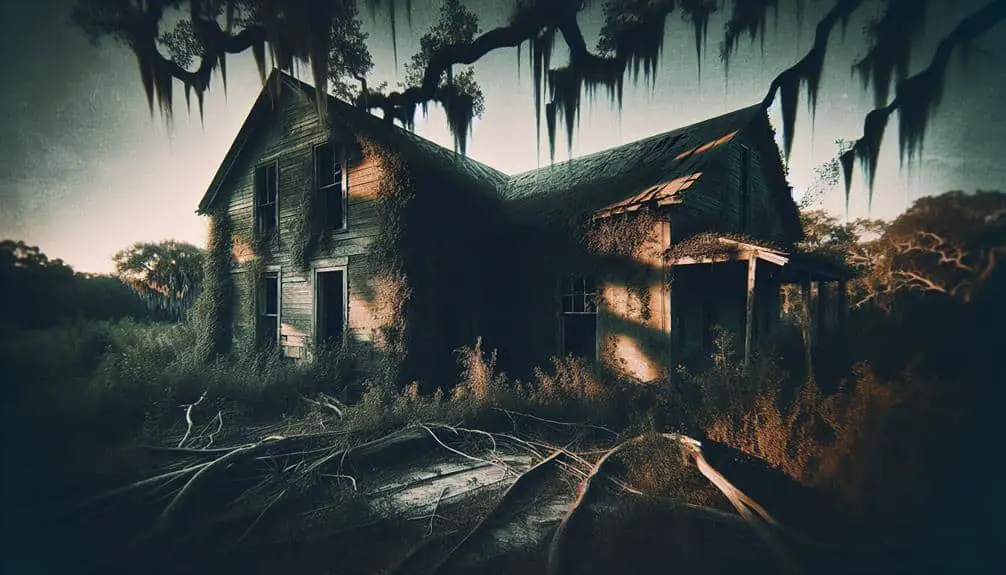Economic shifts and urbanization trends lead to Southern suburban towns being abandoned. Declining industrial opportunities, population shifts, and aging infrastructure pose challenges. Industries facing issues reduce job availability, while urban expansion displaces residents. Revitalization efforts focusing on job creation and inclusivity are essential. Population declines result from urban sprawl and migration to cities. A proactive approach to sustainable development can reverse these trends. Addressing safety risks and environmental hazards in abandoned towns is key for potential redevelopment. Solutions exist to combat abandonment in Southern suburban areas, tackling various issues for a brighter future.
Key Points
- Population shifts to urban areas lead to abandonment.
- Economic downturn diminishes town viability.
- Aging infrastructure poses safety risks.
- Lack of job opportunities drives residents away.
- Urbanization causes neglect of suburban towns.
Economic Shifts Impacting Southern Suburbs
The economic landscape of Southern suburbs is undergoing significant shifts driven by changing market dynamics and evolving consumer preferences. Job loss and economic downturn are key factors contributing to the transformation of these areas. As industries face challenges, employment opportunities dwindle, impacting the overall economic stability of the region. This shift isn't isolated but rather part of a larger trend affecting many suburban areas across the country.
To address these changes, a multifaceted approach is necessary. Encouraging entrepreneurship and small business development can help create new job opportunities and stimulate economic growth. Additionally, investing in retraining programs to equip individuals with skills for emerging industries is vital in mitigating the effects of job loss. Collaborating with local businesses and community organizations to support workforce development initiatives can further bolster the resilience of the Southern suburbs in the face of economic challenges.
Decline of Industrial Opportunities
Amidst shifting economic dynamics, industrial opportunities in Southern suburbs are experiencing a notable decline, necessitating strategic interventions to counteract the negative impacts on local economies. The Southern suburban areas, once thriving hubs during the industrial revolution, are now grappling with a significant downturn in job availability. The rapid evolution of industries towards automation and offshoring has led to a sharp decrease in the number of manufacturing and production roles within these regions.
This decline in industrial opportunities has resulted in widespread job loss, leaving many residents without stable employment. As a consequence, the local economies in Southern suburbs are suffering, with decreased consumer spending and a rise in economic instability. To address this challenge, proactive measures must be taken to revitalize the industrial sector in these areas. Implementing training programs that equip residents with skills suited to the modern industrial landscape and incentivizing businesses to invest in local manufacturing can help mitigate the adverse effects of job loss and reignite economic growth within Southern suburban towns.
Urbanizations Effects on Suburban Areas
Urbanization's impact on Southern suburban areas can be seen in the shifting dynamics of population growth and infrastructure development. As urban areas expand, they often spill over into nearby suburban regions, leading to gentrification impacts on these once quieter neighborhoods. Gentrification, while bringing in new resources and investments, can also displace long-term residents and alter the community's character. This phenomenon can lead to a divide between those who benefit from the revitalization efforts and those who are pushed out due to rising housing costs.
To address these challenges, community revitalization efforts should focus on providing affordable housing options, preserving the cultural heritage of the area, and promoting inclusivity in the development process. By engaging with residents, local authorities, and developers, a balanced approach that considers the needs of all community members can be achieved. It's vital to strike a harmonious balance between progress and preservation to guarantee that Southern suburban areas thrive sustainably amidst urbanization pressures.
Population Trends in Southern Ghost Towns
Analyzing demographic shifts in Southern ghost towns reveals stark population declines and challenges in sustaining community viability. Over the past decades, these once-thriving towns have experienced significant population decreases due to various factors, with urban sprawl playing a significant role. As nearby cities expand and attract more residents, the population growth in these ghost towns has stagnated or even reversed.
The allure of urban areas with better economic opportunities and amenities has led to an exodus from these suburban towns, resulting in dwindling population numbers. This trend not only affects the social fabric of these communities but also poses immense challenges for maintaining essential services and infrastructure.
To address these population trends, strategic planning that focuses on revitalization efforts and attracting new residents is essential. Encouraging sustainable development practices, creating job opportunities, and investing in community amenities can help reverse the population decline and breathe new life into these Southern ghost towns. By leveraging their unique charm and history, these towns can potentially experience a resurgence and regain their vibrancy.
Infrastructure Challenges in Abandoned Towns
What're the key infrastructure challenges faced by abandoned towns in the Southern region?
Abandoned towns in the Southern region grapple with several critical infrastructure challenges due to neglect and the passage of time. These challenges include:
- Aging Infrastructure: The infrastructure in these towns, such as roads, bridges, and utilities, has deteriorated notably over the years. Lack of maintenance and repair has left these structures in a state of disrepair, making them unsafe for use.
- Neglected Buildings: Many buildings in abandoned towns have been left to decay, posing safety risks to anyone who may enter these unstable structures. The presence of these neglected buildings adds to the overall environmental hazards in these areas.
- Environmental Hazards: Abandoned towns often face environmental hazards such as contaminated water sources, asbestos in old buildings, and other health risks that need to be addressed to safeguard the safety of any potential future inhabitants.
- Safety Concerns: The combination of aging infrastructure, neglected buildings, and environmental hazards creates a multitude of safety concerns for anyone considering entering or revitalizing these abandoned towns. Addressing these safety issues is essential for any potential redevelopment efforts.
Frequently Asked Questions
Are There Any Efforts Being Made to Revitalize These Abandoned Southern Suburban Towns?
Efforts to revitalize abandoned southern suburban towns include community initiatives, economic development projects, and infrastructure improvements. Revitalization aims to bring life back to these areas, fostering growth and opportunities for residents.
What Are the Primary Reasons for People Leaving These Areas in the First Place?
When people leave southern suburban towns, it's often due to economic decline and shifting housing market dynamics. Job opportunities dwindle, property values drop, and resources become scarce. Understanding these factors is essential for addressing and reversing abandonment trends.
How Do the Abandoned Towns Affect the Surrounding Communities and Regions?
Abandoned towns in the South have a significant economic impact on surrounding communities, leading to decreased property values and limited local services. Social cohesion suffers as residents face challenges to maintain a sense of community.
What Role Do Local Governments Play in Addressing the Issues Faced by These Abandoned Southern Suburban Towns?
Local governments in southern suburban towns play an essential role in addressing challenges. Through community engagement and resource allocation, they can revitalize abandoned areas, promote economic growth, and enhance quality of life for residents.
Are There Any Success Stories of Abandoned Towns Being Revived and Thriving Once Again?
To witness the revival of once-abandoned towns is inspiring. Communities that embrace change, attract investment, and prioritize economic growth can thrive. Success stories serve as beacons of hope for other struggling areas.



